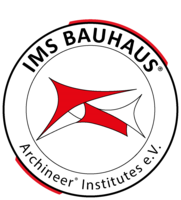Design, planning and structural calculation:
Prof. Dr. Robert Off, Dipl.-Ing. Wolfgang Warisch
Research:
NV. Bekaert S.A. (Patent holder)

Function
This new system for support was shown at the TensiNet Symposium (Brussels, Sept. 19-20, 2003). It consists of a PUR-coated belt with several steel cables and a double layered ETFE-foil, inflated with air to form a cushion. The wide span steel belt works as support for the ETFE-foil, therefore the distance between the belts depends on the strength of the applied foil. Generally this distance will be about 3.00-3.50m, typical for ETFE-foils used today. Using this new system – the “NV. Bekaert S.A. Steelcord Belt System” (developed by the Institute for Membrane and Shell Technologies, IMS for Bekaert) – it is sufficient to join the foil and the belts at the cable crossing points of the cushions. The whole area of the covering can be considered as one big cushion; air is allowed to pass from one cushion field to the other. Therefore, there are no tube connections necessary as in constructions using rigid aluminum girders.
Furthermore, and as the main improvement, this system eliminates expensive and complicated patterning if small wrinkles are acceptable. The air pressure in the cushions and the elasticity of the ETFE-foil enables the renunciation of patterning.
Geometry
With this system, it is possible to design double curved, anticlastic constructions as well as single curved surfaces. Stability is always guaranteed by the air pressure of the cushions. The edges can be stretched by a stiff girder or by a free formed edge cable, as in conventional membrane construction.
Shading
Multi-layered constructions with three or more foils with different kinds of printing and adjustment of air pressure for shading (similar to the atrium roof of the Festo Technology Center are also imaginable as two layered cushions with prints on the upper foil. Thus, the degree of the sun transmittance can be highly regulated.
Variations
Currently, we are investigating a mono-layered, anticlastic shaped ETFE-foil reinforced with belts. In contrast to the above mentioned system, it will be inevitable to conjoin the foil with the belt the whole length. The belts also can be used with other membrane materials to reinforce the membrane. Furthermore, a combination with conventional membrane materials (PES, fiberglass, etc.) will be explored and developed to provide subdivided areas of shading and non-shading.






